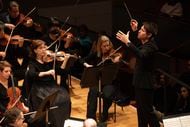Both performers and audience at the Meyerson Symphony Center Saturday night were conspicuously — and commendably — younger and more diverse than at most classical music concerts. Presented by the Dallas Symphony Orchestra, the occasion was a concert by the Sphinx Virtuosi, a conductorless touring chamber orchestra. It’s one of multiple activities under the umbrella of the Detroit-based Sphinx Organization, which promotes classical music representation and recognition of Black and Latino artists.
The ensemble comprised 18 string players of technical excellence and élan. Violinists and violists played standing, cellists seated in chairs, bassists on high stools. Musicians gave friendly spoken introductions to the pieces, although at least a paragraph apiece in the printed program would have been helpful — and dates of composers and pieces.
With lots of energy in the program’s music, including four very recent pieces, performances drew whooping enthusiasm from the audience.
The program opened with Habari Gani (“What’s news?” in Swahili) by Quenton Blache, a Los Angeles-based cellist and composer in his early 20s. Spirited interplays almost could have passed for the work of an English composer of the 1930s or so.
Another cellist-composer, Spanish-born Andrea Casarrubios, was represented by Herencia (Spanish for “Heritage”). Opening with a kind of cello choir, the music became more animated and ardent, with pluckings underlying dancelike energies. After a more reflective passage, including quiet vocalizing, the busy scramble started up again.
From Chilean-born Javier Farías, a guitarist as well as composer in his early 50s, came Abran Paso (”Make way” in Spanish). Busy dithers with close crunches of harmony and tapping strings with bows yielded to a more introspective section, with a viola solo that seemed a combination of aria and cadenza. Busy-ness then resumed, with pounding bass.
Georgia native Xavier Foley was represented as soloist as well as composer in his Concertante for two double basses and string orchestra, subtitled Galaxy. As with the program’s other recent pieces, this alternated ruminative and energetic music. The two solo basses — the other played by Kebra-Seyoun Charles — sometimes sang soulfully in upper registers, sometimes set the ensemble dancing, at one point collaborating in a frenzied quasi-cadenza. This got the evening’s most enthusiastic ovation.
Rounding out the program were works by two Black American composers of earlier generations. The Sinfonietta No. 2, Generations, of Coleridge-Taylor Perkinson (1932-2004) followed a classical symphonic sequence of four movements. The first began introspectively, with crunchy chords exchanged between upper and lower strings, then switched to energetically contrapuntal music. Gently tangy harmonies were explored in a sarabande, with the dance’s defining second-beat emphasis. “Alla Burletta” alternated pluckings and bowings, with bass strings slapped against the fingerboard, and then the finale again stirred up contrapuntal energies.
From Adolphus Hailstork, who’s had a distinguished career as a teacher as well as composer, came the last two movements of his 1990 Sonata da chiesa (church sonata). “Dona nobis pacem” began by weaving lines around one another, building up rich, yearning harmonies. Played without pause, as intended, “Exultate” was aptly celebratory, but with a richly chordal summing up.


